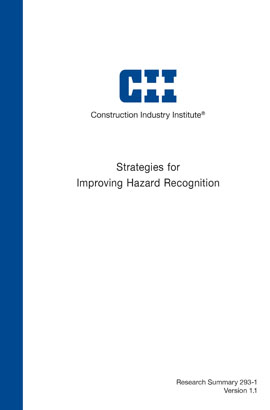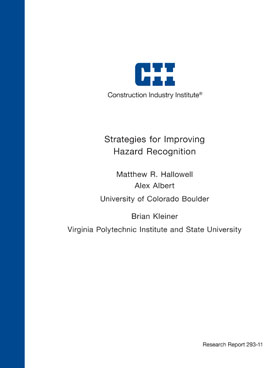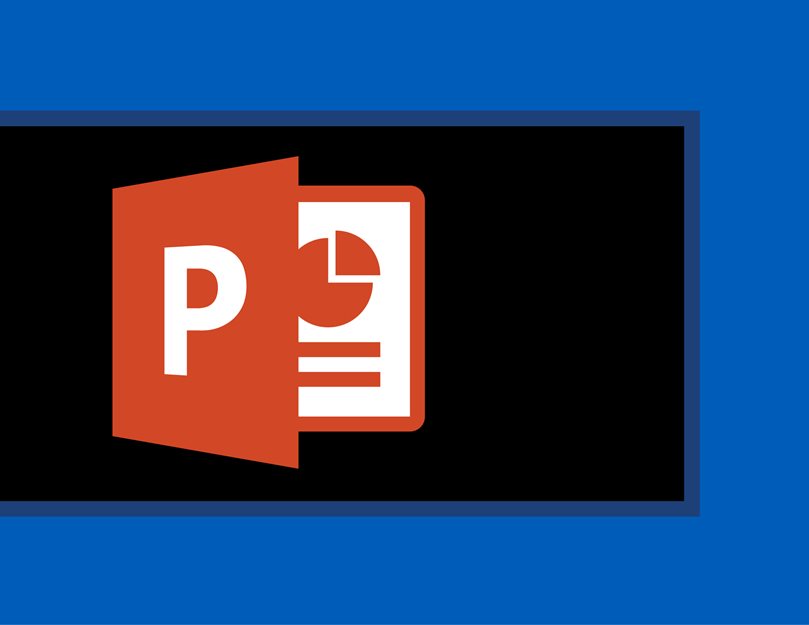
Strategies for Improving Hazard Recognition, Version 1.1
Although injury rates in the construction industry have declined significantly in the last 40 years, the rate of safety improvement has recently slowed substantially. Organizations that hold safety as a core value have expressed a strong desire for new methods that accelerate safety improvement. One of the current weaknesses revealed by recent research is the lack of adequate hazard recognition skills among construction personnel on diverse and dynamic projects (Carter and Smith 2006; Center for Disease Control and Prevention 2012). To address this problem, Construction Industry Institute (CII) Research Team (RT) 293 set out to develop transformative strategies and practical hands-on tools that directly improve workers’ skills for recognizing and communicating hazards. Hazard recognition is a core competency upon which all other safety processes are built. Without strong hazard recognition skills, even safety planning activities that are potentially highly effective (e.g., job hazard analyses and site audits) will not achieve their objectives.
The first phase of the study involved developing a comprehensive list of hazard recognition strategies from safety literature used in a diverse range of industries, including aerospace, the military, manufacturing, mining, construction, and many others. The research team identified more than 100 hazard recognition techniques that were either new to construction or not used specifically as hazard recognition improvement tools. The team used the nominal group technique—a research technique that capitalizes on the expertise of a group—to select the three with the greatest potential for step-change improvement. The three strategies include the following: 1) a pre-job safety meeting quality measurement (SMQM) maturity model that facilitates continuous improvement of the pre-job hazard identification and communication process; 2) a hyper-realistic augmented training environment—called the System for Augmented Virtuality Safety (SAVES)—that immerses workers in a jobsite simulation; and 3) a visual-cue-based Hazard Identification and Transmission (HIT) Board that records hazards during task evaluation and in real time as the job progresses.
Because the three strategies were new to construction and were completely conceptual, the research team developed prototype versions of each tool in the second phase of the study. After completing these prototypes, the team conducted empirical field tests in the third phase to verify the strategies’ effectiveness with active work crews. Specifically, the team used the multiple-baseline testing (MBT) approach for experimental field testing because it would allow for the establishment of a cause-and-effect relationship between the strategies and hazard recognition improvement. This empirical data collection and analysis method provides a more objective measurement than the more subjective survey method of assessment.
The results of the team’s experimental field testing indicate that workers identify less than half of hazards in their immediate work environment before work begins. Alarmingly, this logically means that more than half of hazards are not identified and discussed prior to work. Fortunately, the field tests reveal that the SMQM model, SAVES system, and HIT Board caused net weighted overall improvements in hazard recognition skill of 31 percent, 27 percent, and 30 percent, respectively. To validate these results, the research team used skill tests with high-resolution photographs of diverse construction settings both before and after the application of the three strategies.
The implications of these findings are that this suite of new hazard recognition methods can be used to dramatically improve hazard recognition. This possible improvement is especially important because workers’ ability to identify hazards is essential to their ability to protect themselves. Moreover, the workers’ ability to correctly identify hazards improves the job hazard analyses process, site audits, and all other safety management initiatives. This research summary describes the background for the research, the three strategies that were tested, the specific field testing protocol, and the results and conclusions of the research effort.


